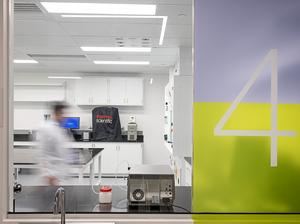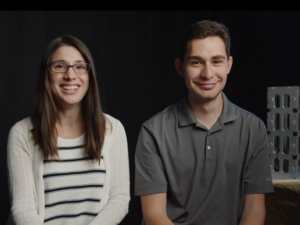It's not everyday you come across a startup that wants people to pee on its technology. But S-There, a venture supported by MIT, MIT linQ and the mVision Foundation, literally does. It's been developing a smart toilet device that will track different things going on in your body based on your urine.
I chatted with two of the venture's team members, Amaia Garcia and Adrian Gomez, and they told me how the idea of throwing technology in the toilet came about - as well as where it's going.
The S-There team members met at a hackathon in Spain. Over the course of 48 hours, they got to know each other as they worked nonstop on an idea they had conceived on the spot.
Their initial focus was to make a device resembling a golf ball that people - namely, diabetics - could toss into their home toilets. It would connect to an app via Wi-Fi or bluetooth and give users feedback on their glucose levels based on their urine. Garcia told me, “It would be non-invasive, painless and affordable.”
In the last six months, the startup’s scope has broadened ever so slightly. “Right now, we’re looking into making different sensors to measure different biometrics: one for glucose analysis and another to measure hydration,” Gomez said.
According to the S-There team, most people struggle with staying hydrated.
“Everyone says people need to drink eight glasses of water a day. That’s not true,” Adrian said. He explained that the recommendation is outdated and that the amount of water an individual should consume depends on a number of factors, including height, weight and level of activity.
With a small, reusable sensor that would be inserted into your toilet bowl, S-There is looking to give you instant feedback on whether you need to drink more water and how much.
“When people receive a measurement in real time, it’s much more effective… You get more engagement,” Gomez said.
In the next week, the startup will have its latest prototype tested - first in Spain, where the team members are currently located for the holidays, and then again when they’re back at MIT at the end of the month. According to Garcia and Gomez, the team will do extensive testing to refine user experience because they know people might find toilet technology a bit taboo.
Now for the question that's been on everyone’s mind while reading this article: How are you supposed to handle a reusable device that literally swims in sewage?
Good news. Since the inception of their project, S-There has altered the design of their device. Instead of having this ball of sensors floating in toilet water while you do your business, S-There has made it so their device can be clipped onto the side of the toilet bowl. And they’re working on incorporating a battery with a year-long lifespan, so users don’t have to get their hands dirty on a regular basis.
Not only does the latest design of S-There’s device save you from repeatedly fishing a pee-covered sphere out of the toilet, it also boasts more practical benefits.
“It’s really difficult to measure the hydration and other biomarkers when you have a lot of water around the device,” Adrian said.
Moving forward, the company will decide whether they want to pursue FDA approval for their device. Ultimately, S-There would like to help users with early-stage detection of chronic diseases, such as kidney issues. If they decide to go that route, they would have to complete the FDA-approval process. However, they recognize they could bring their product to market sooner if they leave any medical claims off the table and market the product simply as a sensor for tracking biomarkers, much like how Fitbit approaches its wearables.
Garcia told me S-There received about €7,000 (about $7,400) to cover their traveling expenses between Spain and MIT. Otherwise, the venture hasn’t received any type of financial backing. The S-There team members have personally invested money in the project and all of the prototyping up until this point. But as they move forward, they recognize they will need a form of external capital - whether it be from angel investors, institutional funding or a crowdfunding campaign.








